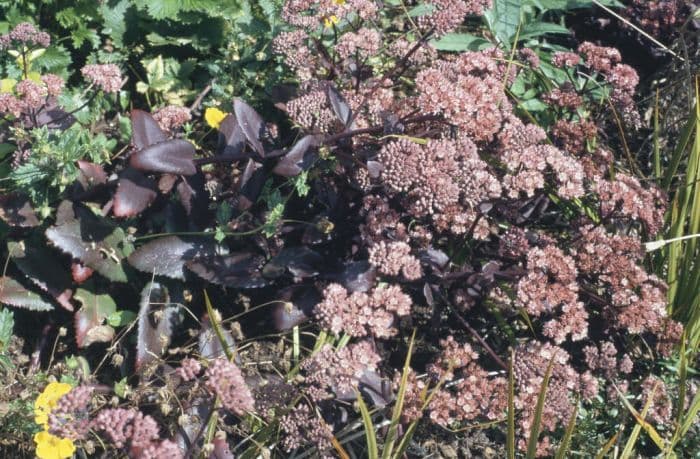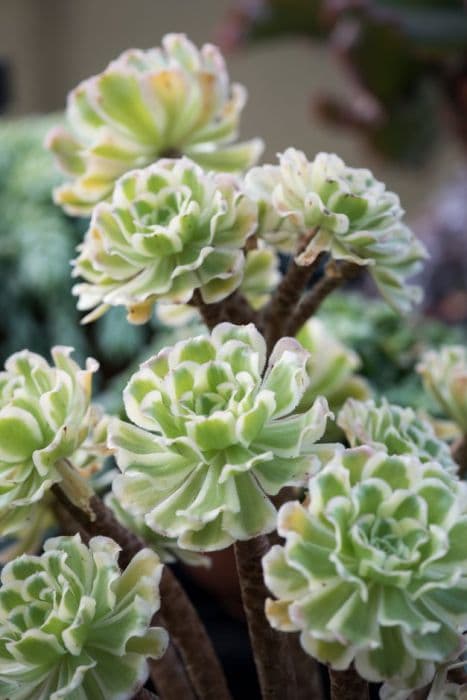Stonecrop Hylotelephium telephium Atropurpureum Group

ABOUT
The Hylotelephium telephium of the Atropurpureum Group, commonly known as Stonecrop, is renowned for its striking appearance that adds a vivid touch to gardens. This enduring succulent possesses fleshy leaves that arrange themselves in a rosette-like fashion. The palette of the leaves is a rich, deep purple to burgundy hue, which adds a dramatic contrast against the greens commonly found in garden spaces. As the Stonecrop blooms, it boasts clusters of star-shaped flowers. The blossoms typically exhibit a pink to red spectrum, which beautifully complements the dark foliage. These flowers tend to attract pollinators like bees and butterflies, adding not only a visual appeal but also an ecological benefit to the surroundings. The appearance of this plant changes throughout the seasons. In the cooler months, the foliage may become even more intensely colored, while the summer brings out the brightness of the flowers. Overall, its robust nature and aesthetically pleasing characteristics make it a favorite among garden enthusiasts looking for both beauty and hardiness in their plant selections.
About this plant
 Names
NamesFamily
Crassulaceae.
Synonyms
Purple Emperor Sedum, Stonecrop, Orpine.
Common names
Sedum telephium, Sedum purpurascens, Sedum telephium ssp. maximum, Sedum telephium var. atropurpureum.
 Toxicity
ToxicityTo humans
Stonecrop is generally considered non-toxic to humans. Ingesting parts of the plant rarely leads to serious poisoning. If consumed in large quantities, however, it may cause mild gastrointestinal upset, such as nausea or diarrhea. It's important to note that individual sensitivities can vary, so some people might experience more pronounced symptoms. If any part of the plant is ingested and symptoms arise, medical advice should be sought.
To pets
Stonecrop is also considered non-toxic to pets. Much like in humans, consumption of this plant is not expected to lead to serious toxicity. However, if a pet consumes a large amount of the plant, it might experience mild gastrointestinal discomfort, including vomiting or diarrhea. Individual pets may have different sensitivities, and if any adverse effects are observed, consulting a veterinarian is advisable.
 Characteristics
CharacteristicsLife cycle
Perennials
Foliage type
Deciduous
Color of leaves
Purple
Flower color
Pink
Height
1-2 feet (30-60 cm)
Spread
1-2 feet (30-60 cm)
Plant type
Herb
Hardiness zones
3-9
Native area
Europe
Benefits
 General Benefits
General Benefits- Aesthetic Appeal: Known commonly as Stonecrop, it adds visual interest to gardens with its attractive purplish-red foliage and clusters of pinkish-purple flowers.
- Drought Resistance: Stonecrop is highly tolerant to drought conditions, making it an excellent choice for water-conserving landscapes and xeriscaping designs.
- Low Maintenance: Requires minimal care once established, making it a suitable plant for gardeners of all skill levels.
- Pollinator Friendly: The flowers of Stonecrop attract bees, butterflies, and other beneficial insects, promoting pollination in the garden.
- Seasonal Interest: Offers a long blooming period from late summer to fall, providing color and interest in the garden when many other plants have finished blooming.
- Erosion Control: Its dense growth habit can help stabilize soil and prevent erosion on slopes or in areas with loose earth.
- Versatility: Stonecrop can be used in a variety of garden settings, including rock gardens, borders, and as ground cover.
- Cold Hardy: It is capable of surviving in cold climates, making it a resilient choice for gardens in cooler regions.
- Propagation Ease: Can be easily propagated from cuttings or division, allowing gardeners to expand their collection or share with others without additional cost.
 Medical Properties
Medical Properties- Anti-inflammatory: Hylotelephium telephium Atropurpureum Group, commonly known as Stonecrop, has been traditionally used to reduce inflammation.
- Analgesic: Stonecrop has been used in folk medicine as a pain reliever for conditions such as minor aches and pains.
- Antibacterial: There are some indications that Stonecrop extracts may have antibacterial properties against certain pathogens.
- Antioxidant: The plant is believed to contain compounds with antioxidant effects that can help in neutralizing harmful free radicals in the body.
- Wound healing: Topically, Stonecrop preparations have been applied to wounds to promote healing and reduce the risk of infection.
- Immune system support: It is sometimes used to enhance the immune system, although scientific evidence is lacking for this use.
- Diuretic: Traditional use includes promoting the release of excess fluids from the body as a diuretic.
- Hepatoprotective: Some studies suggest that Stonecrop may offer liver-protective benefits, but this use is not well-documented.
 Air-purifying Qualities
Air-purifying QualitiesThis plant is not specifically known for air purifying qualities.
 Other Uses
Other Uses- Hylotelephium telephium, commonly known as Stonecrop, can be used in eco-roofing or green roofing systems due to its drought tolerance and ability to thrive in poor soil conditions.
- Stonecrop's robust and succulent foliage serves as a living mulch, helping to retain soil moisture and suppress weed growth in garden beds.
- The plant can be used as a protective ground cover for companion plants, providing shelter for beneficial insects and pollinators.
- Stonecrop is ideal for xeriscaping, a landscaping method that reduces or eliminates the need for supplemental water from irrigation.
- Because of its dense growth, Stonecrop can be planted on slopes or banks to help prevent soil erosion and stabilize the ground.
- The plant's colorful foliage and flowers can be used in floral arrangements as a filler that adds texture and volume.
- During the cold season, Stonecrop's persistent structure offers visual interest in otherwise barren gardens, with its dried seed heads providing a unique aesthetic.
- Stonecrop can play a role in sensory gardens, where its fleshy leaves offer a unique tactile experience.
- The plant may be considered for use in crafting, where dried stems and flower clusters can be incorporated into wreaths or decorative displays.
- In educational gardens, Stonecrop can be used to teach about drought-resistant plants and sustainable gardening practices.
Interesting Facts
 Feng Shui
Feng ShuiThe Sedum is not used in Feng Shui practice.
 Zodiac Sign Compitability
Zodiac Sign CompitabilityThe Sedum is not used in astrology practice.
 Plant Symbolism
Plant Symbolism- Resilience: Also known as Stonecrop, Hylotelephium telephium Atropurpureum Group is a succulent that can thrive in harsh conditions, symbolizing the ability to endure and recover from adversity.
- Abundance: Many succulents, including Stonecrop, have thick, fleshy leaves that can retain water, symbolizing abundance and the capacity to store resources.
- Adaptability: Stonecrop's ability to grow in a variety of soil types and environmental conditions signifies adaptability and the capability to thrive in different situations.
- Longevity: As a perennial plant, Stonecrop represents long life and enduring presence, often surviving for several years with proper care.
- Persistence: The tenacity of Stonecrop to hold on to water and nutrients in its leaves showcases persistence and the determination to survive against the odds.
- Healing: Throughout history, some species of succulents have been used for their medicinal properties; hence, Stonecrop may be associated with healing and the restoration of health.
 Water
WaterThe Sedum 'Autumn Joy,' which is the common name of Hylotelephium telephium Atropurpureum Group, prefers consistent moisture but does not tolerate waterlogged conditions. During the active growing season in spring and summer, water the plant deeply once a week, allowing the top inch of soil to dry out between waterings. In hotter climates, you may need to water more frequently, especially if the plant is in a container. During fall and winter, reduce watering to every other week, or less if there is significant rainfall. Generally, use about one gallon of water per square yard of soil each month, but adjust this based on rainfall and temperature conditions.
 Light
LightSedum 'Autumn Joy' thrives best in full sunlight, requiring at least six hours of direct sun per day. A spot that offers bright, unfiltered sunlight will help the plant achieve the strongest growth and best flower production. If grown indoors, place it near a south-facing window or where it can receive ample daylight.
 Temperature
TemperatureSedum 'Autumn Joy' can tolerate a temperature range from approximately -30 to 90 degrees Fahrenheit. However, it prefers temperatures between 65 and 75 degrees Fahrenheit for optimal growth. This plant is quite hardy and can withstand freezing temperatures in winter, making it suitable for growing in a variety of climates.
 Pruning
PruningPrune Sedum 'Autumn Joy' to maintain its shape and to encourage more robust growth. The best time to prune is in late winter or early spring before the new growth begins. You can also remove spent flowers after blooming to tidy up the plant and potentially encourage a second bloom. Pruning back by one-third every few years rejuvenates the plant and helps to prevent it from becoming too leggy.
 Cleaning
CleaningAs needed
 Soil
SoilAutumn Joy Sedum thrives in a well-draining, sandy or gravelly soil mix with a pH of around 6.0 to 7.5. A mix with one-third sand and two-thirds peat moss or compost can promote healthy growth.
 Repotting
RepottingAutumn Joy Sedum doesn't require frequent repotting and can be repotted every 3-4 years or when it outgrows its container.
 Humidity & Misting
Humidity & MistingAutumn Joy Sedum prefers a drier environment and is tolerant of low humidity levels typical of indoor air.
 Suitable locations
Suitable locationsIndoor
Place Autumn Joy Sedum in bright light, water sparingly.
Outdoor
Plant in full sun, well-drained soil, water occasionally.
Hardiness zone
3-9 USDA
 Life cycle
Life cycleHylotelephium telephium Atropurpureum Group, commonly known as Stonecrop, begins its life cycle as a seed, which upon germinating in the spring, develops roots and a tiny rosette of leaves at the soil surface. The plant enters a vegetative stage, producing fleshy leaves and robust stems as it matures throughout the spring and summer, thriving in well-draining soil and full sunlight. By late summer to autumn, Stonecrop reaches the flowering stage, showcasing clusters of star-shaped, usually pinkish flowers that attract pollinators. After pollination, seeds are produced and dispersed, completing the reproductive cycle, while the plant itself may die back in winter, particularly in cooler climates, displaying dormancy. In warmer zones, the succulent foliage can remain evergreen, though the plant typically exhibits a period of reduced activity during colder months. Each year, Stonecrop can propagate vegetatively by producing offsets or through division of the root system to expand its presence in the garden.
 Propogation
PropogationPropogation time
Spring to Summer
The popular method for propagating the Hylotelephium telephium Atropurpureum Group, commonly known as Sedum 'Autumn Joy', is through division. This should ideally be done in the spring as the shoots are beginning to emerge. To propagate by division, carefully dig up the entire plant with a shovel, making sure to keep a generous amount of soil around the roots to avoid stress. Gently separate the plant into smaller sections, either by hand or with a knife, ensuring that each section has a piece of the root system attached. Replant the divisions immediately, watering them well to help establish the roots. Place them at the same depth they were growing at originally, spacing them around 12 to 18 inches (30 to 45 centimeters) apart to allow room for growth.









